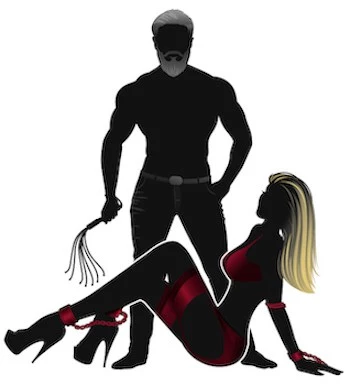Ideally, a BDSM relationship will allow you to experiment with your sexual desires with a loving partner. Sadly, though, this doesn’t always happen. Some partners can introduce toxic aspects that can lead to mental or physical abuse.
These are the three biggest red flags within a BDSM relationship:
- Ignoring safety protocols or trying to undermine them
- Disregarding your limits or boundaries
- Seizing an excessive level of control to limit your autonomy
If you spot any of these things, it’s a sign that you should leave the relationship. If you stay, there is a strong chance that you will end up physically or emotionally hurt. Keep reading to learn more about how these major red flags can manifest.

Ignoring Safety Procedures
BDSM play carries more risks than vanilla sex. If done incorrectly, there is a chance that you could be seriously injured. Because of this, it’s vital to choose a partner who understands these risks and does everything they can to create a safe playing environment.
Sadly, though, not all partners will do this. Here are some signs that your partner is engaging in dangerous play:
- Not using a safe word. Sometimes, a partner will say they don’t have a safe word or want no-limits play. These scenes can be extremely risky, spiraling into uncomfortable or dangerous scenes. Since there is no safe word, you can’t stop the action when things become unsafe.
- Not recognizing a safe word. When one person says the safe word, the scene should immediately end. If your partner ignores your safe word, it’s a clear sign that they don’t take your physical or mental health seriously.
- Scolding you for using a safe word. You shouldn’t be made to feel bad about using a safe word to end a scene. Instead, it should be a chance to talk to your partner about your limits, providing an opportunity to reflect on how future scenes can be adjusted to make you feel more comfortable. If your partner gets angry because you used the safe word, it shows they don’t take your limits seriously.
- Engaging in risky play practices. Using a safe word or gesture is only part of overall safety. For example, if you are doing a shibari scene, you need to have a way to cut through the ropes. Furthermore, having a first-aid kit nearby is important, just in case things go wrong. This article discusses the items you should have in your BDSM first-aid kit.
- Failure to provide aftercare. Aftercare is vital in protecting your mental health, particularly if you experience Dom or sub drop. Your partner should take the time to know what type of aftercare you need and take steps to provide it.
- Dangerous punishments. There are horror tales of people being deprived of food or forced to stand for hours in the freezing cold as a “punishment .”Just because you are being punished doesn’t provide your partner an excuse to put you in a dangerous situation. Consent is still needed. Here are some examples of safe but harsh punishments to try.
Disregarding Your Boundaries
Consent is king within BDSM play. It’s a big problem when your partner disregards your boundaries, forcing you to do things that make you feel uncomfortable. Here are some examples of how this behavior can manifest:
- Not discussing your limits before the scene. Before any type of play occurs, there should be a discussion about what your hard and soft limits are. The idea of “no limits play” is not condoned by the BDSM community, as it can often lead to dangerous situations that make you feel uncomfortable.
- Not seeking consent. Sometimes, a partner might decide to spring something on you during a scene. For example, you might agree to be restrained and whipped. But your partner might decide to start choking you without permission.
- Not respecting your limits. Once you discuss what your limits are, your partner should accept them. If you say something is off-limits, and they do it anyway, that’s a sign they only care about their pleasure, not yours.
- Pressuring you to change your limits. Sometimes, your partner might use phrases like, “You’re not a Dom/sub if you don’t…” As you grow more comfortable, you might decide to try new experiences in the bedroom. But you should make these choices because you want to experiment, not because your partner is coercing you.

You should be able to communicate openly with your partner about what you like and what you are looking for within the relationship. If you aren’t comfortable doing this, it will lead to your boundaries being violated. This workbook can help you talk through your kinks and outline your limits.
Wants An Excessive Amount Of Control
Some people will use BDSM to try and gain coercive control over their partner’s life, trying to limit their autonomy. Here are some examples of what this could look like:
- Stopping you from seeing friends and family. There are a few ways that your partner can try to do this. They might stop you from going out and socializing. Or they might ban you from social media or take away your phone. It should be noted that some types of punishments can involve limiting socializing. The difference is that punishments will end. A controlling partner will seek to block you from seeing loved ones permanently. Often, this has nothing to do with BDSM roleplay; it’s simply because they are jealous.
- Making you change your profession. You should have a boundary between work and pleasure. Your partner shouldn’t seek to make you leave your job or try to stand in the way of a promotion.
- Forcing you to change your personality. A good BDSM partner should accept you for who you are. They shouldn’t try to use harsh punishments to force you to change significant aspects of your personality.

Sometimes, BDSM play can involve ceding control to your partner. For example, in a Master/slave dynamic, the Dom might be able to choose what clothes their sub eats or their food type. But there is a key element to consider. In a healthy relationship, the sub has agreed to hand control of these aspects to their Master. They have sat down to negotiate their limits with their partner, often creating a written document that outlines their wishes. This book gives tips on finding a BDSM relationship dynamic that works for you.
In an unhealthy relationship, your partner will cease power against your will. This might be under the guise of “BDSM training .”This is why you should never begin BDSM training without having an extensive discussion with your partner to ensure you are both comfortable with the limits. To help you do this, you can use this guide to create a Master/slave contract.
Furthermore, this type of training often involves roleplay tasks. For example, a sub might need to have a cold beer ready for their Master at the end of the day. Plus, the slave will have the ability to alter the limits or use a safe word to end the training if they get too uncomfortable.
Final Thoughts
A BDSM relationship should be a safe space for you to experiment with new sexual experiences. But you should have a clear idea of what is acceptable and what behavior is crossing the line.
There are a few obvious red flags that your partner is putting your safety at risk or trying to manipulate your behavior. Hopefully, you now have the tools to spot the warning signs and protect yourself from a toxic partner.


Somebody essentially help to make significantly articles Id state This is the first time I frequented your web page and up to now I surprised with the research you made to make this actual post incredible Fantastic job